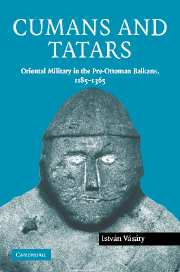Book contents
- Frontmatter
- Contents
- Preface
- 1 Introduction
- 2 Cumans and the Second Bulgarian Empire
- 3 Cumans in the Balkans before the Tatar conquest, 1241
- 4 The first period of Tatar influence in the Balkans, 1242–1282
- 5 The heyday of Tatar influence in the Balkans, 1280–1301
- 6 Cumans and Tatars on the Serbian scene
- 7 Cumans in Byzantine service after the Tatar conquest, 1242–1333
- 8 The Tatars fade away from Bulgaria and Byzantium, 1320–1354
- 9 The emergence of two Romanian principalities in Cumania, 1330, 1364
- Conclusion
- Appendix 1 List of geographical names
- Appendix 2 Chronological table of dynasties
- Appendix 3 Maps
- List of abbreviations
- Bibliography
- Index
6 - Cumans and Tatars on the Serbian scene
Published online by Cambridge University Press: 29 July 2009
- Frontmatter
- Contents
- Preface
- 1 Introduction
- 2 Cumans and the Second Bulgarian Empire
- 3 Cumans in the Balkans before the Tatar conquest, 1241
- 4 The first period of Tatar influence in the Balkans, 1242–1282
- 5 The heyday of Tatar influence in the Balkans, 1280–1301
- 6 Cumans and Tatars on the Serbian scene
- 7 Cumans in Byzantine service after the Tatar conquest, 1242–1333
- 8 The Tatars fade away from Bulgaria and Byzantium, 1320–1354
- 9 The emergence of two Romanian principalities in Cumania, 1330, 1364
- Conclusion
- Appendix 1 List of geographical names
- Appendix 2 Chronological table of dynasties
- Appendix 3 Maps
- List of abbreviations
- Bibliography
- Index
Summary
The Serbians, who belonged to the western branch of the southern Slavs, had long lived under their tribal chiefs, called knezes, between the political spheres of power of Byzantium and Bulgaria. After the fall of the First Bulgarian Empire in 1018, Serbia became an autonomous territorial unit (Serbian župa) within the Byzantine Empire, under the rule of a Serbian grand župan nominated by Byzantium. In respect of religion, the Serbian Orthodox Church was part of the autocephalous archbishopric of Ohrid. The power of an independent Serbia began to rise during the rule of Grand Župan Nemanja, at the end of the twelfth century. His son Stefan Nemanjić became the first independent Serbian ruler whose international recognition was assured by his coronation as king of Serbia by the legate of Pope Honorius III in 1217. (That is why he was later given the epithet prvovenčani, ‘first crowned’.) The autonomous Serbian Church was established a few years later in 1219, when Stefan Prvovenčani's brother Sava Nemanjić created an autonomous Serbian archbishopric under the direct jurisdiction of the patriarchate of Constantinople, at that time exiled in Nikaia. Serbia emerged as a truly great power in the Balkans under the long reign of Stefan Uroš I (1243–76).
CUMANS AT GACKO, 1276
The first appearance of Cumans on the Serbian scene came about as a result of their Serbo-Hungarian contacts.
- Type
- Chapter
- Information
- Cumans and TatarsOriental Military in the Pre-Ottoman Balkans, 1185–1365, pp. 99 - 113Publisher: Cambridge University PressPrint publication year: 2005



